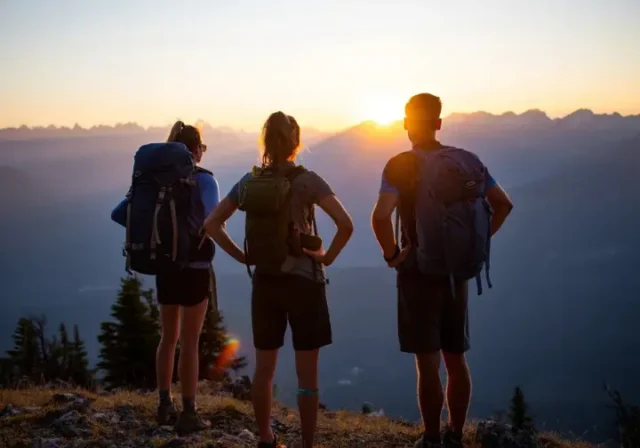In this article
There’s a special kind of magic that happens when a hiker decides not to turn back at the end of the day. To leave the trailhead behind and walk past the point of return, carrying everything you need to call the wilderness home for a night. This is the profound shift from day hiking to wilderness backpacking—from being a visitor in nature to becoming a temporary resident. It’s about trading the fleeting moments of a typical day hike for full immersion and discovering a deeper capability within yourself. This comprehensive backpacking guide is our promise to you: a clear roadmap to help any adventurer confidently take that step.
From Fleeting Moments to Full Immersion
As a day hiker, you experience the trail in chapters. As a backpacker, you get to read the whole book. You’re there to watch the golden hour melt across the landscape, to see the stars ignite in a truly dark sky, and to feel the world awaken with the morning sun. This unbroken presence in the wild fosters a connection that a few hours simply can’t match. You begin to notice the rhythms of the forest—the changing light, the evening calls of birds, and the quiet of the pre-dawn world.
The Challenge of Self-Reliance
At its heart, backpacking is an embrace of self-reliance. The gear on your back is your lifeline, your comfort, and your ticket to freedom. This act of carrying your entire backpacking kit unlocks access to remote, pristine landscapes that lie far beyond the reach of a day’s walk. It’s a challenge, absolutely, but one that rewards you with unparalleled solitude and a powerful sense of independence.
Unlocking New Levels of Accomplishment
There’s a quiet confidence that grows from successfully planning and executing your first multi-day trip. It’s a journey that sharpens your problem-solving skills and builds a resilience you might not have known you possessed. When you navigate a trail, set up your own shelter, and provide for yourself miles from any road, you achieve a sense of accomplishment that is deeply personal and incredibly lasting. This is about more than just a hiking experience; it’s about personal growth.
Our Promise in This Guide
The thought of that first overnight backpacking trip can feel like a huge hurdle, filled with questions about basic backpacking gear, safety, and the unknown. We’re here to flatten that hurdle into a clear path. This great guide will serve as your personal mentor, breaking down the entire process into manageable steps. We’ll cover backpacking basics, walk through the trip planning phase, and teach you the foundational backpacking knowledge to feel secure and prepared.
Gearing Up: A Beginner’s Guide to Your First Backpacking Trip Essentials
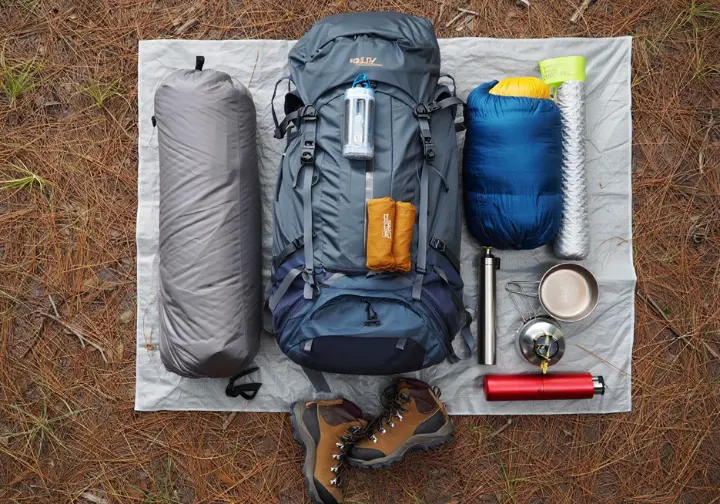
Assembling your first backpacking kit is an exciting rite of passage. It’s about finding a careful balance between function, weight, and your budget, ensuring you have everything you need to be safe and comfortable without feeling like you’re carrying a small car on your back. Let’s break down the core components of your camping gear.
The “Big Three”: Your Foundational Gear
Every backpacker’s kit is built around “The Big Three,” the foundational pillars of your mobile home: your pack—your backpack, your shelter, and your sleeping bag. When starting, focus your budget and attention here. A properly fitted backpack is your most important partner on the trail. For a 1-3 night short backpacking trip, a capacity of 50-65 liters is the sweet spot. But more than size, the fit is everything. When choosing the right backpacking backpack, look for an adjustable torso, a well-padded hip belt to carry the load, and load lifter straps for stability.
Your shelter is your wilderness home. For most beginners, a versatile 3-season backpacking tent is the perfect choice. When considering the backpacking tent selection criteria, prioritize ease of setup and durability. A good tip is to choose a tent rated for one more person than will be using it; that extra space for gear storage inside is a luxury you won’t regret.
Finally, your sleep system is your key to recovery. It consists of your sleeping bag and sleeping pad. Choose a warmer bag with a conservative temperature rating—a 20°F bag is a solid 3-season workhorse. The pad is just as important, providing not just comfort but critical insulation from the cold ground, which is measured by its R-value (aim for 2-4 for 3-season use).
The Ten Essentials: Your Non-Negotiable Safety Net
Think of the Ten Essentials not as a simple checklist, but as a collection of items and systems that form your safety net. Their importance is magnified when you’re miles from the trailhead, forming the bedrock of backcountry camping preparedness. For a definitive overview, the National Park Service maintains the official The Ten Essentials list. This includes robust navigation tools—a physical map and compass, with a GPS as a supplement. It includes a headlamp with extra batteries for hands-free light.
This safety net also covers protection from the elements: sun protection, extra insulating layers (no cotton!), and an emergency shelter like a bivy bag. It’s rounded out with systems for an emergency campfire, repairs (a multi-tool and duct tape), a personalized wilderness first aid kit, an extra day’s worth of backpacking food, and, critically, a way to treat all backcountry water sources to prevent illness.
Clothing and Footwear: Your Wearable Shelter
Your backpacking clothes are your first line of defense against the elements, a wearable shelter that must perform. The cardinal rule is to avoid cotton at all costs; it absorbs moisture and loses all insulation, creating a serious safety risk. Instead, embrace the art of layering. To learn how to layer clothing for hiking, think in three parts: a moisture-wicking base layer, an insulating mid-layer like a fleece, and a waterproof outer shell.
Your footwear is arguably the most critical choice you’ll make. When it comes to selecting proper hiking footwear, your hiking boots must be well broken-in before a trip to avoid trip-ruining blisters. For beginners carrying a full pack on rugged terrain, sturdy boots with good ankle support, perhaps paired with trekking poles for stability, are highly recommended. A final piece of advice? Pack a pair of lightweight camp shoes—a popular camp shoe choice is a simple sandal or clog. Your feet will thank you.
The Backcountry Kitchen: Fueling Your Adventure
Your backcountry kitchen should be simple, efficient, and reliable. For first-time backpackers, a canister backpacking stove is a fantastic choice for its ease of use. The most important rule of the kitchen, however, is that all water from natural sources must be treated. A user-friendly squeeze filter is a popular starting point, but it’s wise to review all methods for safe backcountry water treatment.
Animal safety is also a huge part of your kitchen duties. Proper food storage—using bear-resistant food canisters or learning to hang a bear bag correctly—is a non-negotiable safety measure. Always cook and eat at least 200 feet away from your tent to keep food odors away from where you sleep.
The Blueprint for Success: Planning Your First Backpacking Trip
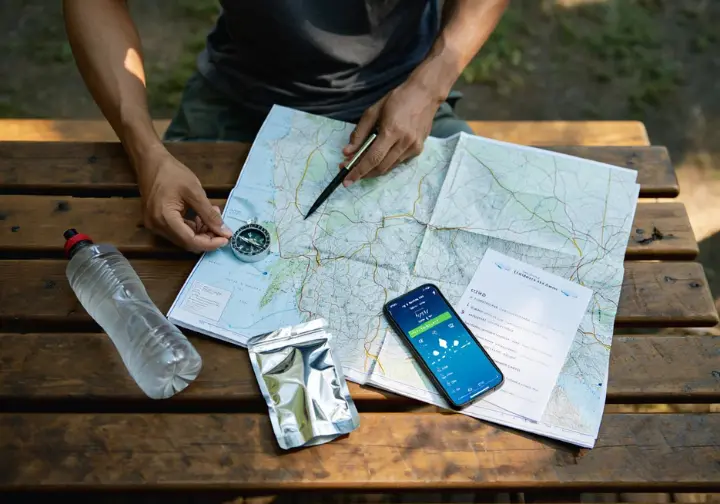
A successful trip begins long before you set foot on the trail. Meticulous planning is what transforms anxiety into anticipation, giving you the confidence to enjoy every moment of your outdoor experience. This is your blueprint, covering everything from finding the right trail to packing your backpack with intention.
Choosing Your First Trail
For your first backpacking adventure, think local, short, and simple. When you select a trail close to home, it simplifies the logistics. Remember that hiking with a 30-pound pack is a different world than a day trip; aim for shorter distances (5-10 miles per day) with minimal elevation gain to start your trek. If possible, choose a well-traveled trail you’ve hiked before; that familiarity will allow you to focus on your new skills. A key part of your planning is researching trail conditions and regulations to ensure there are reliable water sources and established campsites.
Permits, Regulations, and Weather
Once you have a trail in mind, it’s time for logistics. Many popular areas have permit requirements that must be secured well in advance, so do your research early. Also, check for trail-specific rules like fire bans. Weather is your other major planning consideration. It’s critical to get detailed mountain weather forecasts for your specific elevation right before you leave from a source like mountain weather forecasts, and always pack for the worst-case scenario.
Meal Planning and Food Repackaging
Backpacking is a calorie-burning endeavor, so your food is your fuel. Focus on calorie-dense, backpacker-friendly foods, and for a first trip, pack a little extra. You can find excellent backpacking meal planning advice from experts like NOLS. Keep meals simple; easy-to-prepare, one-pot meals are your friend, whether it’s a pre-packaged backpacking meal or something you assemble yourself. To save space and reduce trash, repackage everything into labeled ziplock bags. And don’t forget trail mix and other snacks.
How to Pack Your Backpack Efficiently
There is an art to packing a backpack for hiking, and it makes a world of difference. The principle of loading a backpack for balance and comfort is about using three zones. Bottom: bulky camp items like your sleeping bag. Core (closest to your spine): your heaviest gear like your food and water. Top: items you need access to, like a rain jacket in an easy-to-grab bag. Use your compression straps to cinch the entire bag down tightly to prevent the load from shifting as you hike.
Mastering the Backcountry: Essential Skills for New Backpackers
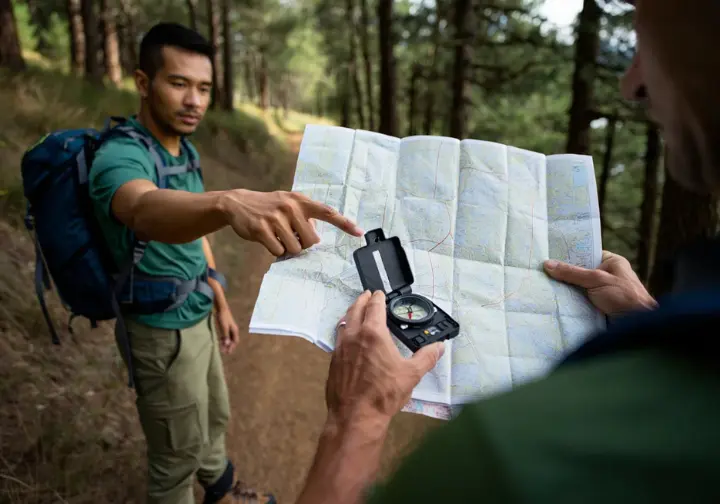
Having the right gear is only half the equation. True confidence in the backcountry comes from knowing how to use it. This is where we move from planning to practice, focusing on the hands-on skills that ensure you are safe, comfortable, and a responsible steward of the wilderness.
Basic Wilderness Navigation
Your map and compass are your most reliable lifeline. While a GPS is a great tool, it’s reliant on batteries and can fail. Knowing how to read the contour lines on a topographic map is a foundational skill. The real magic happens when you orient that map with your compass, making the paper in your hands align with the world around you. There are many excellent guides on how to use a map and compass available from seasoned experts in mountaineering.
Setting Up a Smart Campsite
Choosing where to sleep is a critical decision. When choosing a low-impact campsite, always select a campsite location on a durable surface—like dirt or rock—at least 200 feet from any water source. Before you unpack, look up and around for trail hazards like dead, overhanging branches, often called “widowmakers.” The best way to feel confident is to practice setting up your tent at home a few times. That way, setting up your backcountry base camp is a smooth, stress-free process.
Leave No Trace (LNT): Your Wilderness Ethic
To travel in the backcountry is to accept a responsibility to protect it. The framework for this is detailed in The Leave No Trace Seven Principles, which include planning ahead, respecting wildlife, and minimizing campfire impacts. A core component is knowing how to dispose of waste properly. This means packing out every single piece of trash and digging a proper cathole for human waste 200 feet from water. Good trail etiquette is our shared duty to keep these wild places wild.
Avoiding Pitfalls: Common Beginner Mistakes and How to Sidestep Them
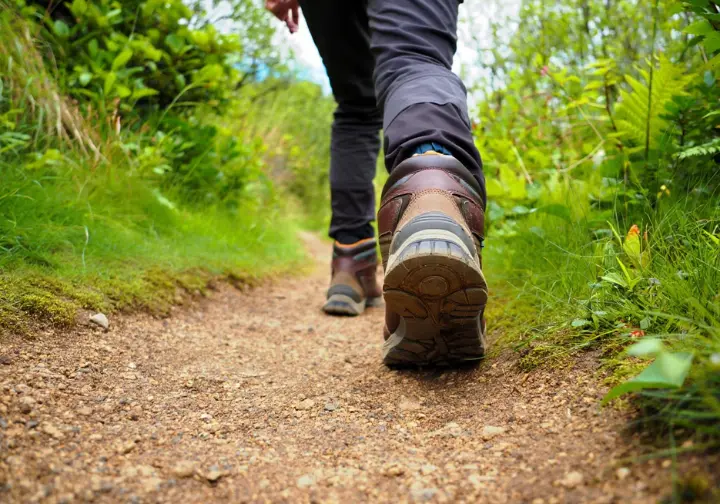
Every experienced backpacker has a story about the mistakes they made on their first few trips. By learning from the most common backpacking mistakes, you can sidestep a lot of the discomfort and frustration, setting yourself up for a much smoother introduction to the world of backpacking.
Overpacking and Under-planning
The most universal beginner mistake is overpacking, driven by the fear of “what if.” A heavy backpack is a joyless one. Fight this urge by using a comprehensive backpacking checklist and scrutinizing every item, opting for multipurpose gear when possible. Another pitfall is not testing your new backpacking gear before you go. Fumbling with a new tent in the dark or discovering your stove doesn’t work at dinnertime is a frustrating and avoidable error. Test everything at home first.
Ignoring Small Problems on the Trail
On the trail, small problems can quickly become big ones. That “hot spot” on your heel is the precursor to a trip-ruining blister. Stop immediately and address it. For expert advice, refer to guides on preventing and treating blisters. The same goes for your body’s fuel. Drink water before you’re thirsty and snack regularly to avoid the energy crash that comes from dehydration or a calorie deficit.
Conclusion: Embracing Your Journey on the Trail
The path from day hiker to backpacker is an incredible journey of personal growth. It’s built on a foundation of careful planning, practiced skills, and a mindset that embraces both the challenges and the profound beauty of the wild. Your first backpacking trip is your real-world classroom. You’ll learn what worked, what didn’t, and what you’re capable of. The trail awaits, inviting you to explore more deeply, connect more profoundly with nature, and discover a new strength within yourself.
Frequently Asked Questions about Your First Backpacking Trip
How heavy should my backpack be for a beginner trip? +
Is it safe for a beginner to go backpacking alone? +
What is the single most important skill to learn before my first trip? +
What’s the best budget-friendly way to get started with gear? +
We are a participant in the Amazon Services LLC Associates Program, an affiliate advertising program designed to provide a means for sites to earn advertising fees by advertising and linking to Amazon.com. As an Amazon Associate I earn from qualifying purchases. We also participate in other affiliate programs. The information provided on this website is provided for entertainment purposes only. We make no representations or warranties of any kind, expressed or implied, about the completeness, accuracy, adequacy, legality, usefulness, reliability, suitability, or availability of the information, or about anything else. Any reliance you place on the information is therefore strictly at your own risk. Additional terms are found in the terms of service.



